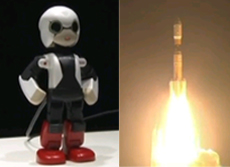Japan launches talking robot Kirobo into outer space
05 Aug 2013
Japan yesterday launched Kirobo, a 13-inch talking robot that can also recognise faces, into outer space to keep International Space Station crew company.
 The robot, launched on a cargo transfer vehicle will reach the International Space Station in six days.
The robot, launched on a cargo transfer vehicle will reach the International Space Station in six days.
The robot formed part of a programme aimed at providing companionship, using such devices, to people living alone including the elderly.
The Kounotori 4 cargo transfer vehicle was launched from the Japan Aerospace Exploration Agency's Tanegashima Space Center riding an H-IIB launch vehicle last morning, according the the Kibo Robot Project website. The project counted Toyota and Robo Garage as two of the project partners.
The black and white robot, with red boots, measures a little over 13-inches (34 centimeters) in height, combines speech, voice and face recognition and other communications functions.
The robot's first task, according to reports would be to communicate with Koichi Wakata, a Japanese astronaut who joined the robot in November. Backup crew member Mirata, who stayed back in Japan, possesses similar capabilities.
"The Kibo robot has a special mission: to help solve the problems brought about by a society that has become more individualized and less communicative," the project wrote on its website.
Japanese-speaking Kirobo would spend 18 months on the ISS, talking to Wakata.
The unmanned rocket also had on board drinking water, food, clothing and work supplies for the six permanent crew members based at the ISS.
Kirobo takes its name from the Japanese words for "hope" and "robot".
The small android weighing around (2.2 pounds) has a wide range of physical motion, with its design inspired by the legendary animation character Astro Boy.
Kirobo is programmed to communicate in Japanese and to keep records of its conversations with Wakata who would be taking over as commander of the ISS later this year.
Additionally, it was expected to relay messages from the control room to the astronaut.
According to Tomotaka Takahashi, Kirobo would remember Wakata's face so it could recognise him when they reunited up in space.
Takahashi said the wished for the robot to function as a mediator between a person and machine, or a person and the internet, and sometimes even between people.
According to Takashashi, the biggest challenge was to make the android compatible with space.
Scores of tests were carried out over a nine month period to ensure Kirobo's reliability.